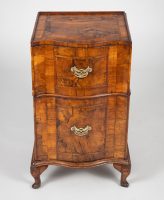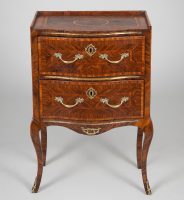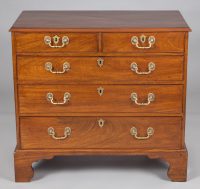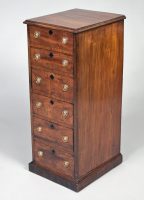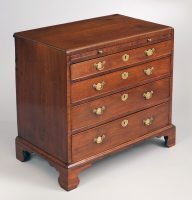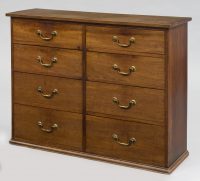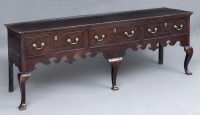Chests & Commodes
The Chest of Drawers
They are is ubiquitous in the home. Anywhere and everywhere! It must be the most practical and useful piece of storage. I can’t name a room that you couldn’t place one in.
We have to go back in time to ancient Egypt to find the earliest form of storage, the chest. Fast forward and the simple chest evolved into the chest of drawers around the end of the 16th century. The drawer was invented probably because someone finally questioned why it was necessary to dig into the chest to get something from the bottom – thus, the drawer. The 17th century saw the rise in popularity of the chest of drawers. The English based their chest design on the French bombe design, which bulges outward in front and on the sides and then curves back in at the base.
The English chest of drawers was fully developed by the beginning of the 18th century. New methods of construction made for more refinement; different woods enriched visibility and made the piece more interesting and different types of chests evolved for different purposes. It took such forms as a chest on stand, chest on chest, bachelors’ chests, the Wellington, campaign chests and commodes. Woods used were oak, walnut, mahogany, rosewood, satinwood, elm, pine, yew, birch and amboyna. Some of these woods were used as veneer.
There are many things to consider when buying an antique chest of drawers. I always like to look at the proportions of the chest first. Does it look elegant or look awkward? Are the drawers graduated or all one size? Most chests are made of walnut or mahogany. If it’s walnut it was made in the early part of the 18th century. If it’s mahogany most likely it was made in the latter part of the 18th century. Are the handles original? The way to tell is to look at the inside of the back of the drawer. If there are other holes next to the screws that hold the present handle in place, then the handles have been replaced at one time. Is there a shadow on the front of the drawer where the handle is now? If so, that is an indication that different style handles were once there. The style of the handles will also tell you what period the chest is.
Antique furniture, especially the chest, will acquire a soft, warm, mellow patina or surface color which develops over the years with multiple waxing’s, fading from the sun, oxidation, age and wear. The back of the chest will tell you if the back boards are original. They should all be of one color or patination with the grain of the wood going in the same direction. Over the years the boards will darken from being exposed to the air and you might see some shrinkage. That is a good sign.
The Commode
They are a much more elegant form of storage. The name is confusing. The word derives from the French word for “convenient” or “suitable.” The reason they are called commodes is because originally they were meant to hold a chamber pot or pitcher and bowl for washing. The name stuck even after the chamber pot was no longer necessary.
They are formal pieces of furniture with doors and drawers and elaborate decoration and look splendid in the foyer with a gilded convex mirror on the wall above or perhaps a pair flanking the fireplace. The commode originated in France in the late 17th century. They would be of a bombe or convex shape with serpentine fronts and curved sides and heavily laden with ormolu mounts. Very often the commode would have a marble top and be supported on cabriole legs.
One of the first French commode makers was Andre-Charles Boulle (1642 –1732), a brilliant cabinet-maker known for using tortoiseshell, brass and pewter inlay into ebony and rosewood. This technique is now known as Boulle Work. His cabinet pieces are works of art and are magnificent. The English commode on the other hand is more restrained with very little or no ormolu. They could have rectilinear fronts or curved fronts. They might have drawers or doors or both. They are usually veneered in satinwood or mahogany with inlay design, painted or have pen and ink decoration. In his The Cabinet-Maker and Upholsterer’s Director (1753), Chippendale used the term “French Commode Table” to describe this piece of furniture. Ince and Mayhew, London cabinet makers, also used the term.
Susan Silver Antiques has both chests and commodes. So give a call for more information or perhaps a shipping quote – (413) 229-8169
 755 North Main Street, Route 7
755 North Main Street, Route 7
